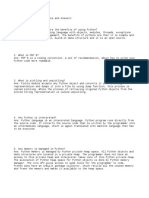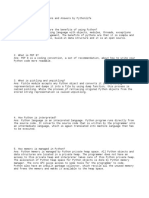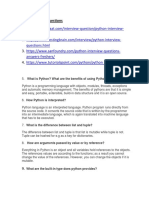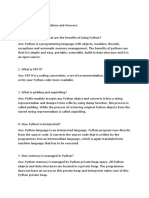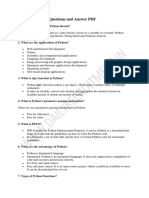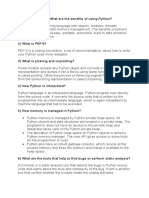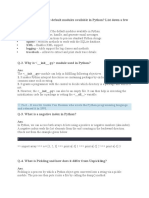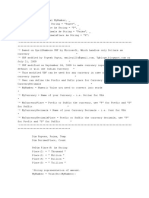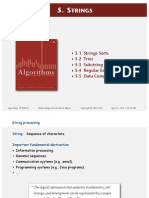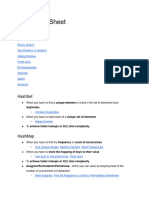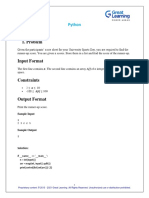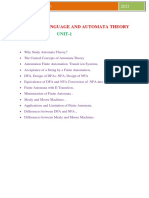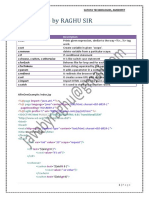50 IMP Python Interview Questions
Comprehensive Python Interview Questions & Answers: Beginner
to Advanced
This document contains a curated collection of Python interview
questions, ranging from beginner-level queries to more advanced
topics. It is designed to help candidates prepare for technical
interviews, focusing on Python fundamentals, data structures,
object-oriented programming (OOP), and advanced concepts . The
file also includes coding challenges and questions related to popular
libraries like Pandas, making it a comprehensive resource for anyone
looking to master Python for technical interviews.
1) What is Python? What are the benefits of using Python?
Ans: Python is a programming language with objects,
modules, threads, exceptions and automatic memory
management. The benefits of pythons are that it is simple and
easy, portable, extensible, build-in data structure and it is an
open source.
2) What is the difference between list and tuple?
Ans: The difference between list and tuple is that list is
mutable while tuple is not. Tuple can be hashed for e.g as a key
for dictionaries.
3) In Python what are iterators?
Ans: In Python, iterators are used to iterate a group of
elements, containers like list.
4) In Python what is slicing?
Ans: A mechanism to select a range of items from sequence
types like list, tuple, strings etc. is known as slicing.
5) What is negative index in Python?
Ans: Python sequences can be index in positive and
negative numbers. For positive index, 0 is the first index, 1 is
the second index and so forth. For negative index, (-1) is the
last index and (-2) is the second last index and so forth.
6) Explain inheritance, polymorphism, and encapsulation with
examples.
Ans:
• Inheritance: Allows a class to inherit methods and attributes
from another class.
• Polymorphism: Allows methods to have the same name but
behave differently based on the object.
• Encapsulation: Bundling data and methods that operate on that
data within a class. Use of private methods to hide details.
7) What are Python decorators, and how do they work?
Answer:
• A decorator is a function that takes another function as input and
adds functionality to it.
Example :
6) Explain how can you generate random numbers in Python?
Ans: To generate random numbers in Python, you need to
import command as import random, random.randint()
This returns a random floating point number in the range [0,1)
7) What is __init__?
Ans: __init__ is a method or constructor in Python. This
method is automatically called to allocate memory when a
new object/ instance of a class is created. All classes have the
__init__ method.
8) How do you write comments in python?
Ans: Comments in Python start with a # character. However,
alternatively at times, commenting is done using
docstrings(strings enclosed within triple quotes).
9) How will you capitalize the first letter of string?
Ans: In Python, the capitalize() method capitalizes the first
letter of a string. If the string already consists of a capital letter
at the beginning, then, it returns the original string.
10) What is a dictionary in Python?
Ans: The built-in datatypes in Python is called dictionary. It
defines one-to-one relationship between keys and values.
Dictionaries contain pair of keys and their corresponding
values. Dictionaries are indexed by keys.
11) What does len() do?
Ans: It is used to determine the length of a string, a list, an
array, etc.
12) Mention what are the rules for local and global variables
in Python?
Ans: Local variables: If a variable is assigned a new value
anywhere within the function's body, it's assumed to be local.
Global variables: Those variables that are only referenced
inside a function are implicitly global.
13) Mention the use of the split function in Python?
Ans: The use of the split function in Python is that it breaks a
string into shorter strings using the defined separator. It gives a
list of all words present in the string.
14) Explain Inheritance in Python.
Ans: Inheritance allows One class to gain all the members(say
attributes and methods) of another class. Inheritance provides
code reusability, makes it easier to create and maintain an
application. The class from which we are inheriting is called
super-class and the class that is inherited is called a derived /
child class.
15) How will you convert a string to all lowercase?
Ans: To convert a string to lowercase, lower() function can be
used.
16) What is the difference between a list and a tuple in Python?
Ans :
• List: Mutable (can be modified after creation), defined using
square brackets [].
• Tuple: Immutable (cannot be modified once created), defined
using parentheses ().
17 )How do you reverse a list in Python?
Ans:
18) What are sets in Python? How are they different from lists?
Ans:
• A set is an unordered collection of unique elements. It doesn't
allow duplicate values and does not preserve the order of
elements.
• A list is an ordered collection of elements that can contain
duplicates.
19) What are the four principles of object-oriented programming?
Ans:
Encapsulation: Wrapping data (variables) and methods (functions)
into a single unit, usually a class.
1. Abstraction: Hiding implementation details and showing only
the necessary information.
2. Inheritance: Allowing a class to inherit properties and methods
from another class.
3. Polymorphism: Allowing different classes to be treated as
instances of the same class through a common interface,
usually via method overriding.
20) How do you concatenate two DataFrames along rows or
columns?
Ans : Use concat()
21) How do you create a pivot table in Pandas?
Ans : Use pivot_table()
22) What is a generator in Python, and how does it differ from a
regular function?
Ans:
• A generator is a function that uses yield to return a value,
pausing the function’s state and allowing it to resume where it
left off.
• It differs from a regular function, which returns a value once and
terminates.
23) What is the purpose of the self keyword in Python?
Ans: self refers to the instance of the class. It is used to access
variables and methods within a class. It is implicitly passed as the first
argument when methods are called on an object.
24) What are sets in Python? How are they different from lists?
Ans: A set is an unordered collection of unique elements. It doesn't
allow duplicate values and does not preserve the order of elements.
• A list is an ordered collection of elements that can contain
duplicates.
25) **What are *args and kwargs?
Ans:
*args allows you to pass a variable number of non-keyword
arguments to a function. It collects these arguments into a tuple.
**kwargs allows you to pass a variable number of keyword
arguments to a function. It collects them into a dictionary.
26) What is the difference between is and == in Python?
• == checks for value equality (i.e., whether the values of two
objects are the same).
• is checks for identity equality (i.e., whether two variables point
to the same object in memory).
• Example
27) What is the purpose of __del__ in Python?
Ans : __del__ is a special method in Python that is used to define
clean-up behavior when an object is about to be destroyed. It is called
when the object's reference count drops to zero, which is when it is
garbage collected.
28) What is Python's zip() function?
Ans : The zip() function takes multiple iterables and aggregates
them into tuples. Each tuple contains the elements at the same
position from each iterable.
Example :
29) What is the enumerate() function in Python?
Ans : The enumerate() function adds a counter to an iterable,
returning a sequence of tuples where each tuple contains an index and
the corresponding element from the iterable.
Example
Output
30) Explain how the sorted() function works in Python.
Ans : The sorted() function returns a new sorted list from the
elements of any iterable, leaving the original iterable unchanged. It
can sort in ascending or descending order and allows for custom
sorting using a key function.
Example :
31) What is the difference between map() and filter() functions?
Ans :
map(): Applies a given function to each item in an iterable and returns
a new iterable with the results.
filter(): Applies a given function to each item in an iterable and
returns a new iterable with only the items for which the function
returned True.
32) What is the return keyword in Python?
Ans : The return keyword is used to exit a function and optionally
return a value to the caller. When a function reaches the return
statement, its execution is terminated, and the specified value is sent
back.
33) What happens if a function does not have a return statement?
Ans : If a function does not have a return statement, it will return
None by default.
Example
34) What are default argument values in Python functions?
Ans : You can specify default values for function arguments. If no
value is provided for an argument, the default value will be used.
Example :
35) What is a function's docstring and how is it used?
Ans : A docstring is a string that is used to document a function,
class, or module. It is placed right under the function definition and
can be accessed using the help() function or the .__doc__ attribute.
36) How do you handle variable-length arguments in Python?
Ans : You can handle variable-length arguments in Python using
*args for non-keyword arguments and **kwargs for keyword
arguments.
37) How can you make a function that behaves differently based
on the type of input it gets?
Ans : You can use type checking inside a function to change its
behavior based on the type of arguments it receives. The isinstance()
function is commonly used for this.
38) What is the difference between join() and split() methods in
Python?
Ans :
join(): This method is used to concatenate elements of an iterable
(like a list or tuple) into a single string. The string that you call join()
on is used as a separator.
split(): This method divides a string into a list based on a specified
separator. By default, it splits by whitespace.
39) How can you reverse a string in Python?
Ans : You can reverse a string using slicing with a step of -1.
40) What is the replace() method in Python?
Ans : The replace() method is used to replace a substring in a string
with another substring. It returns a new string with the replaced
value.
41) How can you check if a string contains only digits in Python?
Ans : The isdigit() method checks if all characters in a string are digits.
42) What is the strip() method in Python?
• The strip() method is used to remove leading and trailing
whitespace characters from a string.
43) What is the startswith() and endswith() methods in Python?
Ans :
• startswith() checks if the string starts with the specified prefix.
• endswith() checks if the string ends with the specified suffix
44) What is the format() method in Python?
Ans : The format() method is used to insert variables or values
into a string. You can use placeholders {} in the string, and the
format() method replaces them with specified values.
45) What is the f-string method in Python for string formatting?
Ans : f-strings (formatted string literals) are a concise way to
embed expressions inside string literals. They are prefixed with
f before the string.
46) What are the basic operations that can be performed on a set
in Python?
• Add elements: add()
• Remove elements: remove() or discard()
• Pop an element: pop()
• Clear all elements: clear()
• Length of a set: len()
• Check if an element exists: in
47) What is the union() method in Python?
Ans : The union() method returns a new set containing all the unique
elements from two or more sets.
48) What is the isdisjoint() method in Python?
Ans : The isdisjoint() method checks if two sets have no elements in
common. It returns True if the sets are disjoint, otherwise False.
49) What is the pop() method in Python?
Ans : The pop() method removes and returns an arbitrary element
from the set. Since sets are unordered, you can't predict which
element will be removed.
50) How do you clear all elements in a set?
Ans : The clear() method removes all elements from the set.












